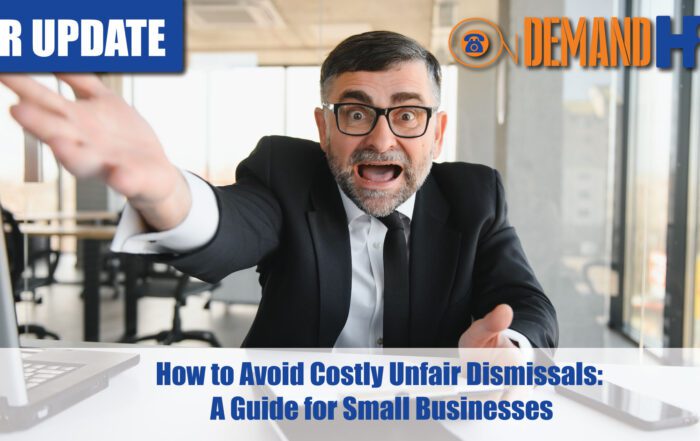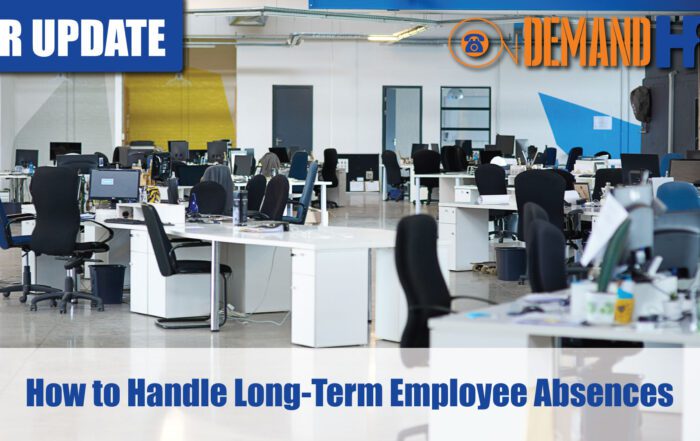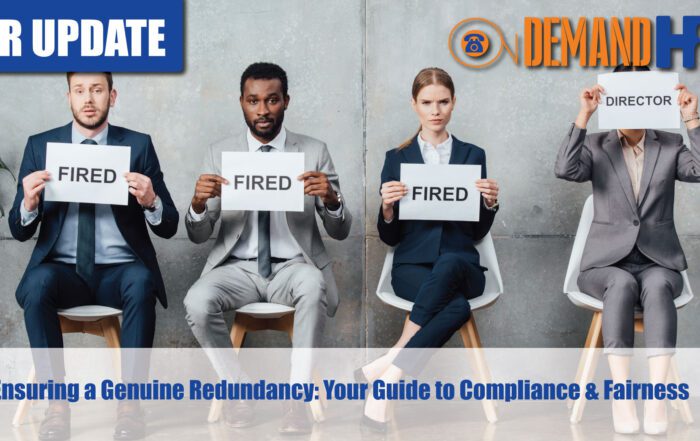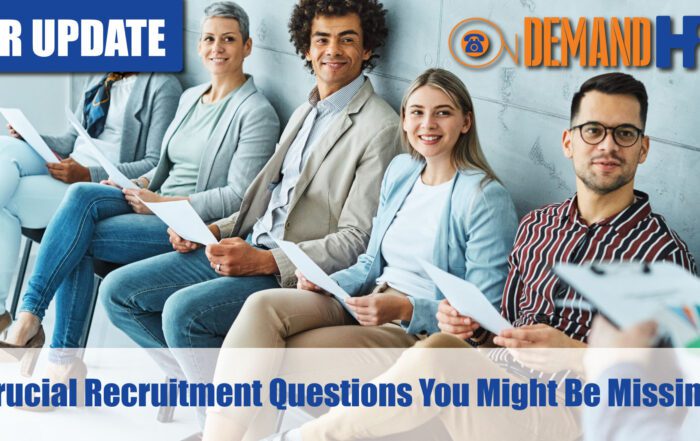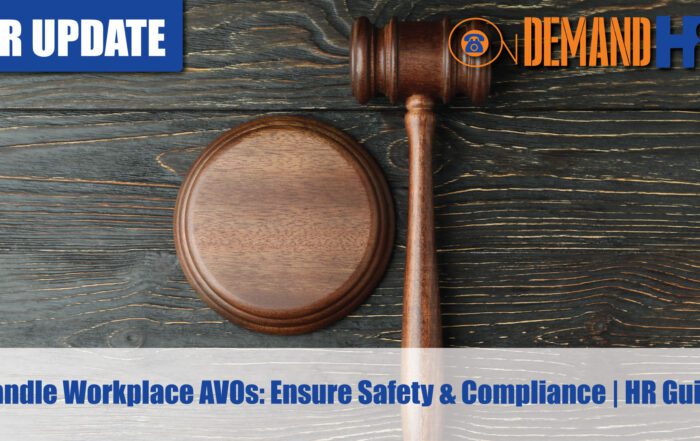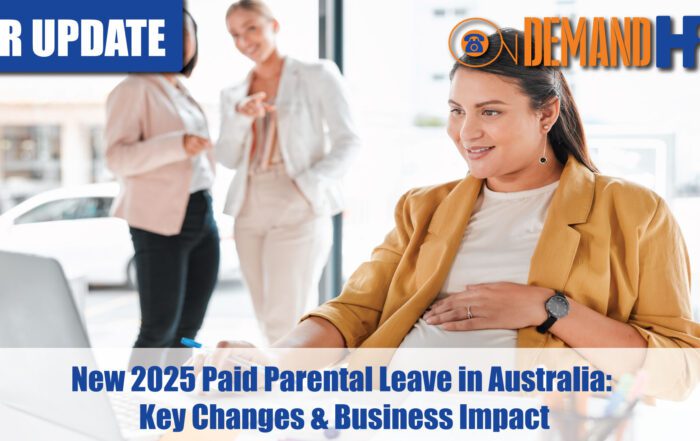Workplace Health & Safety in a Pandemic
In Episode 2 of HR Fridays where Clint will be joined by Matthew Counsel from Altius Group to unpack Work Health & Safety considerations and strategies employers need to consider both during Covid-19 and otherwise. In particular, we look at how to conduct a health and safety GAP analysis, to identify compliance risk and to keep your employees safe.
Please see below for a full transcript of the video
Share the HR or workplace relations challenge facing your business and one of our experienced consultants will be in touch within 24 hours with a strategic action plan or discover the best strategy yourself by accessing out free online training library.
Transcript
Clint Indrele 0:14
Ladies and gentlemen, welcome once again to On Demand HR’s HR Fridays. My name is Clint Indrele. I’m the managing director of On Demand HR. As you would know every Friday at 11:30am we cover a specific Workplace Relations or employment topic of interest for our audience. Good to have some viewers on today listening to the broadcast and watching us live here on Fridays. Please let us know any future topics of interest you’d like us to present on. I’ll be more than happy to put something together to suit the masses. Please also let us know any questions you’ve got about today’s presentation. Happy to answer them on the fly and talk about these certain things.
Clint Indrele 0:58
This whole HR Fridays segment has been put together around providing advice to clients which is at reality and with a real understanding of risk. And what we what we certainly don’t want to do in these segments is provide you with, you know, scare tactics or reasons to do things which simply aren’t true. We’re trying to give you practical and pragmatic advice about WR and employment related topics. For more information about On Demand HR visit www.ondemandhr.com.au. So without further ado, let’s get into today’s HR Friday’s topic.
Clint Indrele 1:35
So today’s HR Friday subject is going to be work health and safety during COVID-19. Let us know your questions throughout the session and we will answer them on the spot. I’d love to introduce a great friend and fantastic business partner of On Demand HR and that is Matthew Counsel from Altius Group who’s going to be out at lead presenter on this great topic of work health and safety today. Good morning, Matthew.
Matthew Counsel 2:04
Good morning Clint, thanks for having me on. Very kind introduction.
Clint Indrele 2:09
Great to have you with us. And yeah, look, I’d love to really get stuck into this whole work health and safety topic. And as you know, we’re obviously very general in terms of our advice to clients on work health and safety. And obviously, we look to you with Altius Group for some specific knowledge and, and obviously services around that type of that type of work. So I’d like to sort of start with a few questions on this. And I wanted to begin with really just for you to give us some insight into what do you think that businesses are most concerned about at the moment from a work health and safety perspective?
Matthew Counsel 2:48
Yeah, no worries. It’s a it’s been a big year. And in terms of businesses, there they’re probably concerned about a lot of things at the moment and for a while their safety was probably, you know, incredibly front of mind at the same time being pushed into the background. With the impact of COVID-19, basically, business as we knew it sort of came to a grinding halt. A lot of businesses then really went into emergency management protection mode and start looking at business continuity. And we found that businesses were not really focused on the traditional elements of safety that they were looking at. But at the same time, without them really realizing it. They’re actually incredibly focused on safety and concerned about COVID-19 and the impact it was having on their business. So it’s been a very interesting year in that respect. Currently, we’re certainly seeing a lot of businesses return to the new normal and it’s not the new normal, it just it is what it is. But I think businesses are starting to, at least in most states, open up, start to operate again and starting to learn to operate with that significant risk that is COVID-19. So in them coming back to business and a bit of back to normality, we’re seeing an increased focused on Work Health Safety. And the shift is certainly moved from the traditional element of safety, which was forklifts, traffic management, construction lift, risk falling from heights to the the biggest risk in 2020, which is COVID-19 and mental health. So businesses certainly come back but there’s a new focus in that element of safety.
Clint Indrele 4:43
Yeah, that’s great, Matt, and thanks for your insight on sort of some of these recent attitudes and trends in respect to work health and safety, and what sort of tips or you know what sort of work work health and safety tips do you have for our audience today and the sorts of things that business should be looking to put in place, you know now or into the near future?
Matthew Counsel 5:05
Yeah, definitely. The biggest tip is just to make a start on it. So many clients when I get out there and meet with them and start to ask around what their safety systems look like, do they have things in place, a bit sheepishly a lot of clients are turning around saying that no, they don’t have the right systems in place and a lot of in particular that small to medium business owners space. They’re experts in what they do. They’ve started this business, it’s their baby, they’ve been growing it and a lot of the time the business has started to grow and get bigger. But the back of house things HR, safety. They tend to get left behind a little bit and it sort of comes from that culture of well I know how to keep myself safe, and I trained Joe and now he knows how to be safe and he trained Sam and they have their past that folklore through the company. And it’s just the way that things are. And it’s just the way that I do them.
Clint Indrele 6:06
Yeah.
Matthew Counsel 6:07
My biggest tip at the moment is from a compliance point of view from a new risk point of view with COVID-19. Probably starting to try and get some of that down on paper, you know, actually map out what your risks are in the business, and make sure that you’ve got a plan. And if I can sort of embellish, I actually had a meeting with a client yesterday and it just shows that it’s not only the safety risks that are evolving and changing but it’s also the business landscape in the way that we’re operating is changing as well. Traditionally, this guy’s business was is they design and manufacture home wares and small gifts and then they distribute those around the company. So his traditional risks. He had a warehouse, forklifts heavy lifting pallets. He had a safety system that was completely compliant and documented around those risks. Moving forward to 2020 his business isn’t what it was when he started it. And these days he designs in Australia, you know, manufacturers overseas, uses third party warehousing structures, all of his risk in the business is actually outsourced these days. But what his business actually does have as a current risk is he has salesman on the road, you know, people out and about road driving. And when I asked him about the safety system around those individuals, he doesn’t have anything documented. He doesn’t have anything documented around fatigue management, drug and alcohol management. And these days, the big question is around mental health as well. What is he doing to manage the mental health of his employees so businesses change. Nothing is static. And this year certainly highlighted that for us as well. So my biggest tip would be, make a start address the elephant in the room and have a conversation about it and start moving in the right direction.
Clint Indrele 8:16
Yeah, really interesting. You mentioned that point about the drug and alcohol policies. And we’ve even seen from our own experience with clients that that’s been a real pain point. And even in the last couple of years, where you’ve had employees test positive to certain substances, and then it’s a question of, you know, what do you do with them in those situations? Is it a situation where the employment can be salvaged? Is it a situation where the employee needs to be moved on? Sometimes it depends on the type of substances and, you know, things that are involved. But I guess just going back to your point a second ago, so in summation, I mean, what would you think are some of the kind of what you’re seeing real compliance exposure at the moment what type of compliance problems or or risks in summary, are you seeing with most of your businesses you deal with?
Matthew Counsel 9:06
Yeah, the biggest key from a compliance perspective, it’s probably the moving goalposts. Yeah. And having the resources to keep up with that as well. So as we know, legislation changes, you know, standards change. And for an organization if their safety system is static, there’s compliance gaps that open up. So in terms of the Australian safety standards, the assurance standards for 4801 were released back in 2001. The ISO standards 45001 were initially released in 2018 and are due to come into effect in March next year is the due date. So for the first time, in 20, odd years, we have new standards that are formally going to kick in and there are gaps that are evolving around those standards that employers previously never addressed. Wity those moving goalposts, again, you’ve got in 2020 align, you’ve had a health related risk, a pandemic that no one saw coming. And I guarantee that there’s some gaps from a compliance perspective on how employers are managing that health risk to their employees. At the same time, you’ve got new standards coming in, which are immediately going to shine gaps in terms of compliance from a company as well. So the biggest challenge would be the fact that the goalposts keep moving in the small to medium business space, you probably don’t have the luxury for a lot of your clients I imagine Clint, don’t have the luxury of having an internal HR representative or specialist and probably not having a work health safety specialist as well. So certainly leaning on partners like yourself, it is really important for them.
Clint Indrele 10:58
Very well summed upand look, one other area I’m interested in we sort of touched on a little bit earlier in today’s live, but just talking about mental health, specifically, obviously, you guys have that work health and safety consulting side. But then you’ve also got that counseling and EAP side, which is a great combination of services, and we really love working with you on that front. What are you seeing in terms of mental health in this COVID environment? Are you getting any feedback out of People Sense in respect to those things? What would you like to share with our audience today?
Matthew Counsel 11:32
Yeah, it’s a bit of a boiling pot to be honest, Clint, and the outlooks not not good. Don’t want to bring down the mood on a Friday but the outlooks not good. I’ve just got a bit of a slide which might put up a few things as well. With COVID-19 and the impact it’s having, we’re really only just starting to say the tip of the iceberg of what’s coming through.And I guess, to try and explain what’s happening on any given day, individually as an individual, our personal resilience and our personal, you know, ability to handle life and the stresses, let’s sort of say that the beaker is about 75% full on any given day for the average person. Now, for the past seven, eight months, we’ve been getting fed from the media, and the genuine concern around this virus, these signals of threats that are starting to come into us as well. We’re designed to pick up on threat that’s the fight or flight reaction. That’s what keeps us alive, thankfully. But when we have this continuous exposure, and again, from the media, pouring in, that sort of negative information, our bodies recieving this and over time it starts to change our belief, it starts to change our perception of our safety. And now all of a sudden, in a day to day seven to eight months in, particularly those down in Victoria at the moment, on a day to day, you’re 75% beaker may have now risen to 85% to 90%. And it’s still possibly somewhat manageable. But then all of a sudden on top of that, we are now as in Victoria, people are in you know, injuring a lengthened period of lockdown and even the term lockdown restrictions, these all have negative connotations, which we’re constantly getting bombarded with. So it’s just this boiling pot at the moment of these triggers and layers upon layers. Then we have people trying to work from home and clean probably during lockdown similar to yourself. You’ve got some little ones and for me working at home during that period, my wife and I were both trying to work nine to five working from the dining table in a two bedroom apartment with a two year old running around who was demanding our attention. And personally, I found my beaker at times starting to boil up a little bit, just in terms of the change, we don’t deal with change very well. So there are other people out there that may have multiple kids and then all of a sudden we’re bringing work life into the home environment and we’ve got those homeschooling stresses and and enough is enough for some people and eventually that beaker will tip over that hundred percent mark. And what we’re saying is from a mental health perspective that this prolonged you know, episode of these triggers are just starting to layer up on us. So, prior pre pandemic, you probably looking at some of the mental health stats that are around one in four to one in five people experience mental health concerns and complications. And they can reach out through services like EAP to get support and reach out to the doctor and get support.
Clint Indrele 15:14
Very good. That’s really good summary of that kind of issue. And thanks very much for sharing some insight on that. I just want to leave with one more sort of key question for you today and then sort of wrap up. And what are your thoughts about the whole working from home trend? Do you think it’s here to stay long term number one, and number two, What what sort of adjustments from a work health and safety point of view should businesses be making if that is the trend?
Matthew Counsel 15:45
Yeah. I don’t know about you, but I do think it’s here to stay. I think there’s a lot of benefits to this to this trend, that businesses will find themselves. Yeah, we’re not going to go back to normality I’m in the Sydney CBD today. And it’s a bit of a ghost town out there at the moment. compared how it used to be. And I think until a solution to COVID comes through. Businesses are going to keep operating within this working from home trend. And I truly believe that this trend will last long enough that it will become the norm. You will certainly have businesses with an old school mindset that will say no, we’re in the offices and things like that, but I think a lot of businesses will adapt, they will look at their facilities, their resourcing, and they will actually encourage working from home. So from a safety perspective, as an employer, your work environment is no longer the four walls of the office, it is extended to the home environment as well. So you certainly need to be looking after the physical aspects at home. But as I mentioned, those home environments aren’t without their triggers and risk and I truly believe there’s a big shift and an important shift towards well being and mental health, we really need to be looking after the person holistically, if we’re going to look after safety in the future.
Matthew Counsel 17:15
Yeah. Now that’s fantastic, Matt. And look, obviously, you know, in these times, I mean, businesses, obviously, we’re under a lot of pressure to compete with so many priorities and look with work health and safety, whilst for the average, you know, business in this environment. They may not think it’s a huge priority. I mean, the one thing we are seeing is that, obviously, with people’s incomes being at threat, you know, there is your legitimate and your non legitimate worker’s comp claims that have come out of that. We’ve certainly seen that firsthand. And I’d like to just sort of give you one last sort of point, Matt, just to explain to our audience and so we’ve obviously worked with you about some conducting a gap analysis as a kind of a review of a business’s work health and safety kind of current circumstances if you like, do you want to just very briefly explain that as a closing point in today’s session?
Matthew Counsel 18:11
Yes, certainly. So what is a gap analysis? Basically, we will be coming out and reviewing your safety systems so that your safety system is how your company manages and supports safety. Typically, it might look like the documented policies and procedures that you have that help you comply with legislation, but also keep your people safe. So we will actually come out, we’ll review your policies and procedures against the current standards against best practice. But then also have a look at how you are implementing those in the workplace. So it’s not just a point of reviewing documents it’s about seeing how you were putting those in practice. And are there any gaps that we can recommend? From a work health safety, psychological risk point of view, there’s a lot of room for improvement for organizations. As I said, we’re certainly moving from that traditional physical safety concept of forklifts, trips, slips, falls, manual handling. The biggest risk going forward is what I mentioned. I think it’s around mental health and well being so there’s likely to be some gaps there. And, you know, we’d certainly love to be speaking to you about it and supporting people and keeping everyone safe. And well.
Clint Indrele 19:28
Yeah, to see that last point about mental health. We get a bit of research on this ourselves at On Demand HR last year, and whilst mental health typically of the overall percentage was not a huge percentage of the total amount of claims, one thing that we noticed was that I think it was mental health claims at cost in terms of claims costs were either three or four times higher than your average claims costs. And that’s really interesting when you think about the nature of some other injuries that do happen at work, but I just like to close off todays session, just by talking to all of our viewers today with look, the one take out from today is certainly, if work health and safety is on your mind, please get in touch with us here at On Demand HR. And we can we can coordinate with Matthew Counsel from Altius Group in relation to conducting a GAP analysis. So for those who are looking or considering doing something like that, visit our on demand HR website www.ondemandhr.com.au Just finally Matthew Counsel, thank you so much for giving up your time today for our segment here on HR Fridays. Thanks for your wonderful insight into work health and safety. We look forward to continuing to work with you with various different clients that we have and mate you enjoy your weekend. And we look forward to having you back on this segment sometime again in the future.
Matthew Counsel 20:53
Thanks, Clint. It’s great segment and thanks for having me on.
Clint Indrele 20:57
Thanks once again, Matt. And thank you very much to our audience for those who missed it live, you can certainly watch this on replay and let us know of any future topics that are of interest to you and we’ll be more than happy to present them. And from Clint Indrele here Managing Director of On Demand HR and Matthew Counsel, it’s goodbye for now.
Matthew Counsel 21:16
Thanks, Clint.

